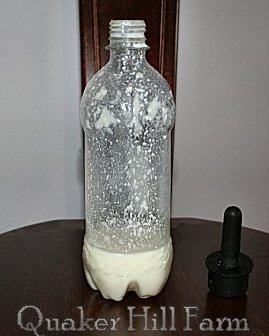Quaker Hill Farm
QuakerFarm.com
PART 2 - How to Bottle Feed a Baby Goat
If this site has been helpful to you, please
donate to help support it.
 continued from Part 1
continued from Part 1
The problem with pasteurizing milk, from our perspective, is that pasteurization
not only kills harmful bacteria (and theoretically
the CAE virus), pasteurization also kills beneficial bacteria as well.
Raw milk which has been
carefully collected from healthy, content does and then
handled with sanitary care is just bursting with wholesome goodness in a way that
pasteurized milk
never can, because the food value of pasteurized milk has been somewhat diminished
from heat treatment.
The fact is, that while we feel raising goat kids on pasteurized milk has merit,
we prefer to know that our does
do not have CAE in the first place. It not enough to just believe that CAE can not be passed
on to
humans; theories come and go. We simply do not want to eat any food from any animal who is
not in prime health themselves.
In regards to health, it is interesting to note (though not widely known)
that studies have indicated that
as many as
86% of commercial dairy cow herds
throughout the US have cows within their herds with BLV - Bovine leukemia virus - which, according to one source, is
"closely related to a human tumor virus." This means
that when milk is pooled, it can
cause up to a 90% to 95% contamination rate. A 2007 USDA fact sheet reveals a rather chilling
statement regarding this matter:
"The high individual animal prevalence of BLV
reported in the Dairy 1996 study suggests that testing and culling seropositive animals may not
be a cost effective method to control the disease. Instead, preventing
disease transmission by implementing preventive practices would likely be more
cost-effective."
This is probably one of the reasons why the legal
issue of milk
pasteurization and the regulation of milk sales
is staunchly
enforced. It is no wonder that the consumption of raw milk and regulation
of the sale of milk is the public concern that it is in the US. In most states,
selling raw milk
is simply illegal - and probably it should be if dairy herds are not required to
be lukemia free across the board - this includes organic dairies as well. Not to mention,
that when dairy cows become old or
too sick to profitably manage, where do they go? Where does
store bought hamburger really come from? Think about it.
You see, in the interest of wholesome food, these are just more reasons
why it is important for you to consider
where your food really comes from. Personal relationships and transactions
with local farmers in or around
your community go a long way towards improving the actual quality of the
food you eat and serve to your family.
Anyway, back to bottle feeding goat kids!
Then, we experimented with raising goat kids in tandem with their mothers. That is, we taught
them to use a bottle immediately
after birth and followed through bottle feeding them
at regular intervals for the first few weeks, while at the same time, leaving the
kids with their mothers so they had the benefit of on-demand feeding. Those kids were always growthy,
and grew up friendly and easy to handle.
Regardless of the debate on which way is best,
either way, it is a good idea to prepare for the fact that at some point
a newborn goat kid may need
your assistance, even if
you had intended to let your doe raise her own kids.
A kid needing assistance happens
when you least expect it. At least it does here in the north country where winters are long
and springtime
struggles to settle in as late as mid 5th month.
So, be sure to plan ahead. Put aside some frozen colostrum when you have a doe freshen.
Try and freeze a pint or so, and make sure to do so every year because colostrum is best if
used
before it is a year old (in the freezer).
Supplies
Assemble supplies together in a special box or bag specifically set up for this purpose.
I like to use a tool box. Tool boxes are sturdy enough for barn use, and
they keep supplies organized and
store easily when not in use.
Have the
following items ready:
A nipple (I prefer to use lambar nipples)
A plastic soda bottle
A candy thermometer (if you are going to pasteurize)
Paper towels or cotton hand towels (which is what we use)
2 Clean bath towels

Nipples come in several varieties. We use lambar nipples so we can transfer baby goats
them
from
a bottle to a lamb nurser at any time in the future. This is easier to do using the same type
of nipple they are already familiar with.
DO NOT clean bottle nipples
with bleach. Even a mild bleach solution will quickly ruin all types of nipples.
Next....
Continued in
How to Bottle Feed
a Baby Goat PART 3
|